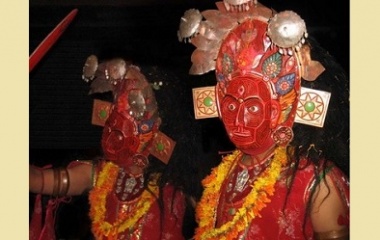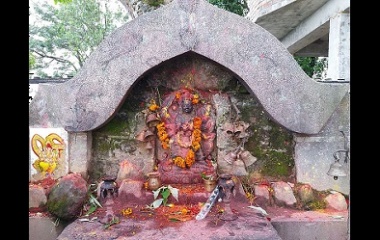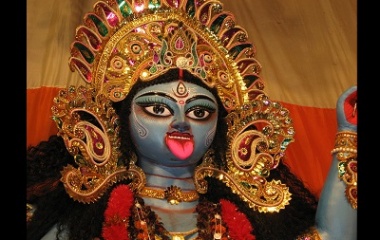- Pronunciation: KAH-lee
- Origin: Hindu
- Role: Goddess
- Symbols: Sword, Dance
- Consort: Shiva
- Other Name: Kaushika
Who Is Kali?
Kali is a Hindu goddess. She is sometimes considered to be a strong mother-like figure and some say she symbolizes motherly-love. But she is more commonly known as the goddess of death and time. She is often associated with violence and sexuality.
She is the reincarnation of Shiva’s wife, Parvati. The goddess also embodies Shakti, the Hindu word for feminine energy, fertility, and creativity.
Origins
The name Kali is derived from Sanskrit. It means “she who is black” or “she who is death”. She does have several other names, including Kaushika, Chaturbhuja Kali, and Chinnamasta. She is appealing to both gods and mortals. As an embodiment of time, Kali devours all things. She is traditionally worshipped throughout India but especially in South India, Kashmir, Assam, and Bengal. She is one of the most widely recognized Hindu goddesses today and one of the few to whom blood sacrifices are still made.
Legends and Stories
Kali is one of the most well-known Hindu goddesses, mostly because of her immense power and responsibility. Here are two myths that show just how powerful the deity is.
The Birth of Kali
There are a few different versions that tell how Kali came to be. The first version involves Durga, the warrior goddess with ten arms, each carrying a type of weapon. She rode a lion into battle and fought with the buffalo demon, Mahishasure. Durga’s fury grew and from her anger, Kali formed. Kali immediately ate any and all demons around her and decapitated their heads, threading them on a chain to wear around her neck. No one was able to stop kali’s attacks. One day, Shiva lied down on a path to stop kali. She immediately calmed down once she realized who she was standing on.
Another version says that Kali appeared when Parvati, Shiva’s wife, shed her skin. Her skin transformed into Kali and explains why her skin is so dark. The dark color of her skin is symbolic of eternal darkness associated with destruction.
The final version says that Daruka was terrorizing both mortals and gods. He could only be killed by a woman. Parvati was asked by the gods to handle the demon. She jumped down Shiva’s throat to retrieve a poison he had swallowed years before. When she met the poison, she transformed into Kali. She jumped out of Shiva’s throat and quickly eliminated Daruka.
Raktabija
There is another tale regarding Kali’s origins. There was a terrible demon named Raktabija. He was terrorizing both the mortals and gods. To make matters worse, whenever a drop of his blood would hit the ground, a new demon would appear. So whenever someone would try and attack the demon, more demons would appear. The gods decided they needed to work together and come up with a plan. They combined all of their divine energy in an effort to produce one super being that would be able to destroy the demon once and for all. The result was Kali. She quickly sought out Raktabija, along with his army of demons, and swallowed the army whole. This prevented any blood from hitting the ground. She defeated Raktabija by cutting off his head with her sword and then drinking his blood to ensure that no more demons would enter the world.
Band of Thieves
If Kali was angered, she was always quick to seek revenge. A group of thieves wished to make a human sacrifice to the god but they unwisely chose a monk. They dragged him to the nearest temple where they prepared to make the sacrifice in front of Kali’s statue when it suddenly came to life. She was furious that the thieves planned to sacrifice a monk and sought revenge by decapitating all of the thieves. The monk was able to escape and Kali spent the rest of her day tossing the decapitated heads around for fun.
Family
Kali is the consort of Shiva. She is the dynamic aspect of the duo while Shiva is the silent aspect. Together, they fulfil the highest Supreme. They balance each other’s powers out. It is said that if you look at the gods with human eyes, you will see them as separate beings. But if you gaze on them with your inner eye, you will see that they are truly one force.
Appearance
In artistic representations, Kali is usually portrayed with either black or blue skin. She is usually naked except for a painted clay crown. She has multiple arms and the number varies. Some pictures show her with as few as four arms while others show her with up to 18. Each arm is usually holding something. These objects include a dagger, cup, chakra, whip, bell, sword, trident, drum, lotus bud, and a shield. Kali is usually shown seated with her legs crossed. She usually has eight feet.
Her poses do vary though. In some representations, she is shown slaying demons. She is sometimes standing with one foot on Shiva while holding a severed head. Her expression is terrifying and her tongue hangs out of her mouth dripping of blood. In these scenarios, she is shown wearing a skirt of severed human arms, earrings of dead children, and a necklace of decapitated heads.
Symbology
There are many themes surrounding Kali, including change, hope, courage, rebirth, joy, and cleansing. There are also many symbols associated with the goddess, including swords, honey, flowers, and dance.
Her multiple arms are also symbolic. When shown with four arms, it is said she symbolizes the complete circle of life, both creation and destruction, along with everything in between. Her right hands represent her creative side while the left are usually shown holding either a sword covered in blood or a decapitated head to represent her destructive side. The sword is said to represent knowledge and by using the sword, she cuts away ignorance and opens the gates of freedom.
Kali also has three eyes, which are said to represent the sun, moon, and fire. With these elements, she is able to observe all modes of time, including the past, present, and future.











Goddess Kali gets my total respect
Thanks for being a true mother figure
And protector
Yama VS Kali…🧐🧐🧐I’m Sure that Yama or maybe Kali will win in War 2